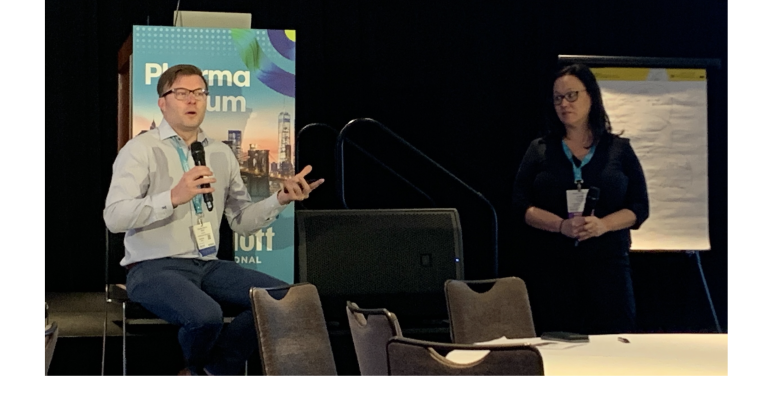Given the two-plus years of virtual meetings the entire business world had to endure, there is much “unlearning” that needs to take place among attendees of today’s in-person events. The mindsets and behaviors that became ingrained while attendees sat in front of a computer screen to participate in meetings—it was mostly just watching, actually—must be reversed. And it’s on event planners to do that, or else a meeting’s objectives won’t be reached, time and money will be wasted, and attendees won’t be eager to participate in future in-person events.
The magic element that planners must incorporate into a meeting to deliver a strong return on investment: deep engagement that comes from stimulating the five human senses.
During the 2023 Pharma Forum conference in New York City, an experienced planner presented several battle-tested ideas for doing just that. Chris Mix, an executive producer for Ashfield Event Experiences, led a session for about 75 life-science event planners with this premise: “Engagement is any tangible action, sense, or experience that connects an audience to presented content. It’s what transforms your audience into players in the story that your content is supporting.”
Putting Concepts into Action
“When you accept a broader understanding of engagement, you’ll find more tools at your disposal,” Mix noted. “It’s not just Q&A sessions, polling, and word clouds—engagement is anything that creates an experience based on human senses.”
He cited his process for developing a recent oncology-related product launch. To connect with both internal reps and HCPs, he approached his session-building efforts through these considerations:
• What does the patient experience smell like?
• What do cancer cells feel like to patients?
• What does hope look like for patients?
• What does the joyous news of remission sound like?
• How can we curate food-and-beverage menu items to connect with meeting content?
By creating sessions that used live and recorded storytelling and role-play scenarios interspersed with segments where attendees could ask questions and provide their perspectives, Mix kept attendees focused so they would absorb information and lessons not only from the sources on stage but also from each other.
For another life-sciences company’s event, Mix’s challenge was to deliver new compliance rules that reps had to learn and follow. With a topic that’s “just so boring,” as he put it, the approach to delivering the content had to have unusual energy. So, rather than put the firm’s compliance director in the difficult role of speaking for 50 minutes to an audience of phone-scrolling reps, he opted to deliver content in the form of a competition: a professionally produced game show complete with an upbeat, smooth-talking host, flashing lights, and various sounds for correct and incorrect answers. Six-person teams from different regions played against each other over the course of 30 questions, while the leaderboard was displayed on stage behind the show host—to cheers and groans—after each correct answer and its reasoning were presented.
Other Engaging Ideas
Mix cited a recent trend where general-session stages are set closer to ground level to promote interaction and engagement. A lower stage makes it easier for presenters to walk into the aisles, while attendees might be more inclined to ask questions when there’s less of a barrier between them and the presenter. Also, “a lower stage makes things feel more equal,” Mix says. “The presenter is speaking with people rather than talking down to them,” which appeals to younger attendees in particular.
Taking this idea one step further, planners could try setting the main room so that attendees can see each other’s faces. “Watching others engage is contagious,” Mix notes. In addition to considering set-ups such as a small-theater-style half-circle or even an arena-style full circle of seating around the stage, “is there an option to bring in varied seating options, such as café and lounge-style furniture set across different zones in the room?”
As for refreshment breaks in the prefunction space, “try to develop easy activations for those areas. Anything hands-on that puts information and concepts up close to attendees will build connections and memories to the content presented throughout the day,” says Mix. “This could be through models, mode-of-action videos [that visually explain how a drug or device acts in the body], or games and contests based on your content, all of which encourage networking and fun learning opportunities."
It’s also possible to use the areas between the main-stage ballroom and the breakout rooms to build out elements that makes the walk for attendees more of a themed journey that grabs their attention. For example, “use signage with inspirational characters and quotes as clever directional signage, or make it a simplified scavenger hunt” where attendees take photos instead of gathering items.
Lastly, the sound experience throughout a meeting can reinforce content in a subtle or unsubtle fashion. “Is there a playlist you could develop that matches your themes and objectives? Not just a playlist of popular radio songs, but even something more immersive.” For instance, matching the music and sounds to a meeting’s destination will help attendees mentally connect the content with the experience, making it easier to remember in the long term.





